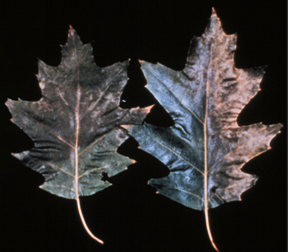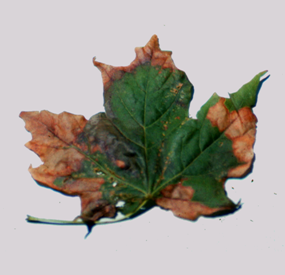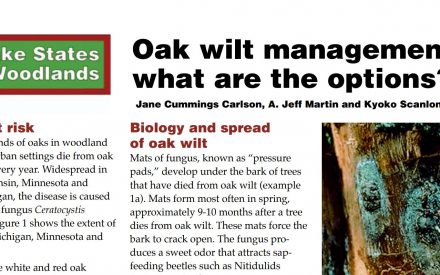What is oak wilt?

Oak wilt is a lethal fungal disease that affects virtually all species of oaks. Oaks in the red oak group (oaks with pointed leaf lobes) such as red, scarlet, black and Northern pin oak are most susceptible. Oaks in the white oak group (those with rounded leaf lobes) such as white, bur, post, and swamp white oak are less susceptible.
What does oak wilt look like?
Initially, single branches on infected trees wilt and die. Leaves on these branches often bronze, or turn tan or dull green, starting at the tips or outer margins. Leaves may also droop, curl, or fall from the tree. Infected trees eventually die. Oak wilt can kill oaks in the red oak group in less than one month. Oaks in the white oak group usually have less severe symptoms and rarely die in a single season.
Where does oak wilt come from?
Oak wilt is caused by the fungus Bretziella fagacearum, which survives in infected living oaks and in oaks recently killed by the disease. The fungus can also survive in firewood harvested from an infected tree.
Sap beetles are attracted to mats of the oak wilt fungus in infected trees, pick up spores of the fungus on their bodies, then carry spores to healthy trees. These beetles are attracted to trees that have been recently wounded by wind or storm damage, or by pruning. Oak bark beetles such as Pseudopityophthorus minutissimus and Pseudopityophthorus pruinosus are also known to move the oak wilt fungus from tree to tree. In particular, Pseudopityophthorus minutissimus has been observed more frequently in Wisconsin in recent years. The relative importance of sap beetles vs. oak bark beetles in the transmission of the oak wilt fungus in Wisconsin is not known at this time.
Once Bretziella fagacearum has infected an oak tree, natural grafts between roots of oak trees growing near each other serve as a means by which the fungus moves from tree to tree. Root grafts most commonly form between oak trees in the same oak group (see above for details), but root grafts between red oak group and white oak group oaks can also occur on occasion.
How do I save a tree with oak wilt?
Removing infected oaks is often the best way to manage oak wilt. Before removing trees, be sure to disrupt root grafts between infected and other nearby oaks. This will help limit tree to tree movement of the fungus during the removal process. Burn or bury wood from diseased oaks, if possible. If you decide to keep the wood, remove the bark, pile it in one place and cover it with a heavy tarp, burying the tarp edges with soil until you use it. This will limit sap or bark beetle access to the pile and reduce the risk that these insects will acquire the oak wilt fungus. Propiconazole injections can be used for oak wilt management, but these treatments work best when used before, rather than after, oak trees are infected.
How do I avoid problems with oak wilt in the future?
Prune oak trees only during the dormant season when sap and bark beetles are not active. If you must prune during the growing season (e.g., due to storm damage) IMMEDIATELY cover wounds with paint. Sap beetles can visit wounded oaks within 10 minutes of wound formation. Monitor oaks for oak wilt and remove infected trees promptly.
For more information on oak wilt:
Contact the University of Wisconsin Plant Disease Diagnostics Clinic (PDDC) at (608) 262-2863 or pddc@wisc.edu.
Authors: Jim Olis* and Brian Hudelson, UW-Madison Plant Pathology
Last Revised: 03/20/2024
D-number: D0075
*Completed as partial fulfillment of the requirements for a BS in Plant Pathology at the University of Wisconsin Madison.
References to pesticide products in this publication are for your convenience and are not an endorsement or criticism of one product over similar products. You are responsible for using pesticides according to the manufacturer’s current label directions. Follow directions exactly to protect the environment and people from pesticide exposure. Failure to do so violates the law.
Thanks to Ann Joy, Laura Jull and Ann Wied for reviewing this document.
A complete inventory of UW Plant Disease Facts is available at the University of Wisconsin-Madison Plant Disease Diagnostics Clinic website: https://pddc.wisc.edu.
Send a Plant Sample for Analysis
Be cautious when self-diagnosing plant health issues. Very few diseases can accurately be diagnosed by eye.
Contact the UW Plant Disease Diagnostics Clinic (PDDC), and for a small fee, clinic staff can examine a plant, determine the cause of the disease/disorder, and provide advice on how to control or prevent the issue.
Download Article





 Armillaria Root Disease
Armillaria Root Disease Two Lined Chestnut Borer
Two Lined Chestnut Borer Anthracnose
Anthracnose Oak Wilt Management—What Are the Options?
Oak Wilt Management—What Are the Options?


